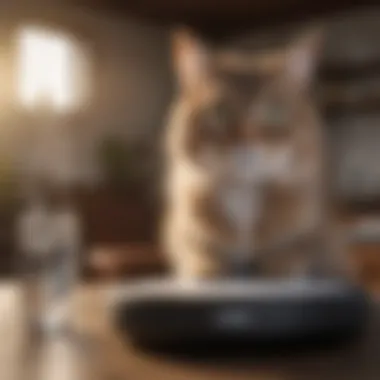The Efficacy of Air Purifiers in Reducing Cat Hair


Intro
The presence of cats in our homes brings joy and companionship. However, it also introduces challenges, particularly when it comes to managing cat hair and allergens. These can lead to discomfort for both pet owners and guests, especially those with sensitivities. This article delves into the efficacy of air purifiers as a solution to mitigate these issues. By exploring their mechanisms, filter types, and practical applications, readers can gain insights into the effectiveness of these devices. The goal is to provide a comprehensive understanding of how air purifiers can function alongside traditional pet care strategies to enhance the quality of life at home.
Pet Care Essentials
Daily Nutrition Requirements
For well-being, cats need a balanced diet. Appropriate nutrition supports their immune systems, which can help reduce allergic reactions to pet dander. Commercial cat food often meets these requirements, but some pet owners opt for home-cooked meals. Understanding the proper balance of carbohydrates, proteins, and fats is vital. Seek advice from a veterinarian to choose the best feeding options for your cat's unique needs.
Exercise and Playtime
Regular exercise is critical for a cat’s health. It helps maintain a healthy weight and reduces stress. Engaging in playtime can also reduce the amount of loose fur and dander in the home. Cat toys such as laser pointers, feather wands, and interactive puzzles can promote activity. Beneficial play can decrease shedding, which alleviates allergen accumulation.
Grooming Tips
Grooming is an essential aspect of pet care, especially for cats. Regular brushing helps remove loose fur and minimizes allergens that become airborne. For short-haired cats, grooming once a week may suffice, while long-haired breeds might need daily sessions. Using specialized grooming tools, such as rubber brushes or grooming gloves, can enhance the efficiency of this task. Not only does grooming reduce allergens, but it also strengthens the bond between the cat and owner.
Health and Wellness Check-ins
Regular veterinary check-ups are crucial for ensuring optimal health. Cats can develop health issues that may exacerbate allergies and dander. By staying informed about your pet’s health, you can better manage potential allergen sources. This includes vaccinations and routine health screenings. A well-maintained pet is less likely to contribute to an allergen-laden environment.
The Role of Air Purifiers
Air purifiers can help improve indoor air quality significantly. They work by filtering out particles, including pet hair, dander, and other allergens, from the air. Understanding the different types of filters used in air purifiers can guide your purchase decisions.
Types of Filters
Air purifiers commonly utilize HEPA filters, carbon filters, and UV light technology.
- HEPA filters: These are effective at trapping small particles, including pet allergens. They can capture particles as small as 0.3 microns, providing a high level of filtration.
- Carbon filters: They are excellent for removing odors, which can also be triggered by pets.
- UV light technology: This can help in killing airborne bacteria and viruses, enhancing overall air quality.
"Using air purifiers alongside regular cleaning can lead to a significant reduction in allergen levels in your home."
Practical Implementation of Air Purifiers
To maximize the benefits of air purifiers, consider the following recommendations:
- Position: Place the purifier in common areas where pet hair accumulation is highest.
- Usage Frequency: Run the device continuously for best results.
- Maintenance: Regularly replace filters and clean the unit to ensure effectiveness.
Integrating air purifiers into your home can support existing pet care strategies. Together, they create a healthier living environment for all inhabitants.
The End
Managing cat hair and allergens requires a multifaceted approach. By combining air purifiers with diligent pet care practices, cat owners can reduce the burden of allergens in their homes. This not only improves indoor air quality but enhances overall well-being for both cats and their owners. Understanding how to use air purifiers effectively, along with consistent pet grooming and health checks, will lead to a more pleasant and comfortable home.
For additional information on air purifiers and pet care strategies, feel free to visit resources like Wikipedia, Britannica, Reddit, or Facebook.
Prologue
In homes with cats, the presence of hair and allergens becomes a common challenge. This article addresses the significant role that air purifiers play in managing these issues. Understanding how air purifiers can effectively reduce cat hair and allergens is essential for pet owners who strive to create a comfortable living environment for both themselves and their feline companions.
Air purifiers serve as valuable tools in maintaining air quality. They not only capture visible pet hair but also target microscopic dander that can trigger allergic reactions. For cat lovers, the desire to provide a clean, healthy home is paramount. Therefore, exploring the efficacy of these devices becomes not just a concern, but a necessity.
In the following sections, we will delve into the mechanics behind air purifiers, examine the varied technologies available, and discuss their limitations. This comprehensive analysis aims to empower readers with knowledge that can help them make informed decisions regarding air purification and its role in enhancing indoor air quality.
Understanding the Common Issue of Cat Hair
Cat hair is an inevitable part of owning a pet. Cats naturally shed fur, contributing to the accumulation of hair in various spaces around the home. The shedding varies depending on the breed, season, and individual health of the cat. Understanding why and when cats shed hair can help owners manage this process more effectively.
Some breeds, like the Maine Coon or Siberian, have long, thick fur and shed significantly more than those with shorter coats. Additionally, many cats will experience heavier shedding during seasonal changes, typically in spring and fall. Recognizing these patterns is crucial in adopting suitable preventative measures.


Regular grooming is essential not only to remove loose hair but also to maintain the cat’s skin health. By brushing their cats consistently, owners can minimize the amount of hair that becomes airborne and settles in living spaces. These practices combined with the use of air purifiers can ameliorate common hair-related issues.
Why Cat Hair Matters
Cat hair matters for several reasons, particularly in relation to allergies and respiratory health. The proteins found in cat hair can act as allergens, leading to discomfort and health issues for sensitive individuals. When these proteins are inhaled, they may trigger allergic responses such as sneezing, coughing, and skin irritation.
For families with children or elderly members, the impact of cat hair can resonate even more profoundly. Allergic reactions can lead to exacerbations of existing health issues, such as asthma. Hence, managing cat hair is not only important for aesthetics but also for the well-being of all household members.
Furthermore, cat hair collects dust and other allergens, contributing to poor indoor air quality. Individuals who suffer from allergies or asthma should prioritize reducing pet hair in their homes. This brings us back to the importance of air purifiers, which can significantly aid in mitigating these concerns by filtering out both hair and airborne allergens effectively.
"Understanding and managing cat hair is a critical component for a healthier home, especially for allergy sufferers."
By adopting a multi-faceted approach that includes both grooming and air purification, pet owners can drastically improve their indoor environment. This leads to not only a cleaner home but also a healthier and more enjoyable living space.
How Air Purifiers Work
Understanding how air purifiers work is vital for pet owners, especially those dealing with cat hair and allergens. Air purifiers have become an essential tool in maintaining indoor air quality. They can help reduce airborne particles, such as pet hair and dander. Air purifiers operate based on different principles and technologies. Knowing these can guide cat owners in selecting the right device for their needs and preferences.
Basic Principles of Air Purification
Air purification fundamentally relies on the process of filtering and removing contaminants from the air. Purifiers create a flow of air that passes through various filters designed to capture pollutants. The main steps in this process include:
- Air Intake: Air is drawn into the purifier, often using a fan.
- Filtration: The air passes through one or more filters that capture dust, allergens, pet hair, and other particles.
- Clean Air Release: The filtered air is then circulated back into the room.
Typically, these devices reduce particles as small as 0.3 microns, which includes a significant portion of pet dander. Overall, air purification mainly enhances indoor air quality and provides comfort for individuals prone to allergies.
Different Technologies Used in Air Purifiers
Air purifiers utilize various technologies to achieve their filtering goals. The effectiveness can vary based on the type of filter used. Here are some common types:
HEPA Filters
High-Efficiency Particulate Air (HEPA) filters are well-regarded for their ability to trap a wide range of airborne particles. A key characteristic of HEPA filters is their efficiency in capturing particles as small as 0.3 microns with a rate of over 99.97%.
- Benefits: Their high efficiency makes them a popular choice for homes with pets. They effectively reduce pet dander, hair, pollen, and dust mites.
- Limitations: While HEPA filters excel at capturing particles, they do not absorb odors or gases. This might necessitate the use of additional filters for comprehensive air quality improvement.
Activated Carbon Filters
Activated carbon filters specialize in removing odors and harmful gases. Their unique structure, filled with tiny pores, allows them to adsorb various volatile organic compounds and smells.
- Key Feature: The primary advantage of activated carbon filters is their ability to improve air taste and smell, making them beneficial alongside HEPA filters.
- Considerations: However, they might have limited effectiveness on larger particles like cat hair. Regular replacement is also needed, as their adsorbent capacity can become saturated over time.
Ionizers
Ionizers work by emitting negatively charged ions into the air. These ions attach to airborne particles, causing them to clump together and settle out of the air. This technology is considered less common compared to filters.
- Benefits: Ionizers can reduce dust and allergens effectively, especially in confined spaces. They often operate quietly and have a low maintenance requirement since they do not need frequent filter changes.
- Drawbacks: However, they may produce ozone, which can be a health concern. It is essential to verify if the ionizer complies with standards for ozone emission to ensure safety.
In summary, understanding how air purifiers work and the technology they employ is essential for choosing the right device to address cat hair and allergens in the home. Carefully evaluating the features, advantages, and limitations of each type can lead to better decision-making for cat owners.
Impact of Air Purifiers on Cat Hair
Air purifiers play a significant role in managing cat hair and allergens. The presence of cats in homes often leads to issues related to excessive shedding and airborne particles. An air purifier can alleviate these problems, enhancing the overall living environment. Understanding the impact of these devices on cat hair is crucial for pet owners seeking effective solutions to minimize allergens and maintain air quality.
Studies on Air Purifiers and Pet Hair Removal
Several studies have been conducted to analyze the effectiveness of air purifiers in removing pet hair from indoor spaces. Research indicates that air purifiers equipped with high-efficiency particulate air (HEPA) filters can capture a substantial amount of airborne hair particles. One study found that devices utilizing HEPA technology were able to decrease pet dander and hair in the home atmosphere significantly.
These findings suggest that air purifiers can be an effective tool for pet owners who face challenges related to allergens. While the removal of visible hair from surfaces is essential, capturing fine particles that may lead to allergic reactions is equally important. The studies highlight the importance of combining air purifiers with regular cleaning practices for optimal effectiveness.
Effectiveness of HEPA Filters


HEPA filters are highly esteemed for their filtration capabilities. They can trap at least 99.97% of particles that are larger than 0.3 microns. This includes cat hair and dander, making HEPA filters particularly suitable for homes with cats. Their effectiveness lies in the way they function—by trapping particles in a dense web of fibers, thereby preventing them from recirculating in the air.
Many air purifiers on the market feature HEPA filters, which is essential for those with allergies. When selecting an air purifier, pet owners should prioritize devices with certified HEPA filtration systems. Not only do these filters reduce allergens, they also contribute to a cleaner, fresher indoor environment.
“Air purifiers with HEPA filters are an investment in your health, particularly in homes with pets.�”
Ultimately, the efficiency of air purifiers in managing cat hair and allergens is influenced by both the filter type and the frequency of use. Consistency is key when attempting to minimize pet hair in any living space.
Limitations of Air Purifiers for Cat Hair
Understanding the limitations of air purifiers in managing cat hair is essential for pet owners. While these devices can significantly improve air quality by reducing airborne particles, there are boundaries to their capabilities. Owners often expect air purifiers to eliminate all traces of cat hair and dander completely. However, this is impractical. The effectiveness of air purifiers should be viewed as part of a broader strategy for managing pet-related allergens.
What Air Purifiers Cannot Do
Air purifiers are not a catch-all solution for pet hair issues. The following points highlight their limitations:
- Surface Residue: Air purifiers primarily filter the air and do not clean surfaces. Cat hair can settle on furniture and floors, remaining untouched by the purifier.
- Noise Control: Some pet owners may require a quieter environment. A running air purifier, especially at high speeds, may produce noise that can disturb both pets and humans.
- Cost Considerations: High-quality air purifiers come with a substantial price tag. Electric consumption and filter replacements add ongoing expenses, which may not align with every budget.
In summary, while air purifiers can reduce the amount of airborne allergens, pet owners must still consider other cleaning strategies.
Filtering Out Dander vs. Hair
Air purifiers are typically more effective at filtering out smaller particles such as dander rather than larger substances like cat hair. Here are some key comparisons to note:
- Particle Size: Cat hair is physically larger than dander, making it more challenging for standard filters to capture these larger fibers. Dander is microscopic and can remain suspended in the air longer, which is why many purifiers target these particles instead.
- Filter Type: Most air purifiers use HEPA filters, which are designed to trap small particles. While these filters can significantly reduce dander, removing all cat hair from the environment is less effective.
- Combination Approaches: Owners should utilize additional strategies, such as regular vacuuming and grooming, to manage cat hair effectively. Relying solely on air purifiers is not a comprehensive solution.
Air purifiers serve an important role in improving indoor air quality, yet they cannot replace effective cleaning habits. Understanding their limitations allows cat owners to adopt a more integrated approach to managing allergens.
Complementary Strategies for Managing Cat Hair
Dealing with cat hair requires a multifaceted approach. While air purifiers play a significant role in reducing airborne allergens and hair, they are not a complete solution. Other strategies are essential to effectively manage cat hair in your home. These complementary strategies must be integrated into your routine to create a healthier living environment.
Regular Grooming Practices
Grooming your cat is not just about aesthetics; it is a fundamental practice to control shedding and maintain fur health. Regular brushing removes loose hair and minimizes shedding. The frequency of grooming can depend on your cat’s breed and coat type. For long-haired breeds, daily grooming may be necessary. Conversely, short-haired cats might require grooming a few times a week.
Investing in the right grooming tools is crucial. Brushes come in various forms including slicker brushes, bristle brushes, and grooming gloves. Each tool serves a different purpose and can help reduce hair left on furniture and floors. The more consistently you groom your cat, the less fur and dander circulate in the air.
Additionally, regular grooming can help in identifying skin issues at an early stage, leading to better health for your pet. Beyond the immediate benefits of hair removal, grooming can also strengthen the bond between you and your cat.
Routine Cleaning and Maintenance
Maintaining a clean home is vital when managing cat hair. Regular cleaning routines will complement the use of air purifiers. Vacuuming should be done frequently, focusing on areas where your cat spends time. Many vacuums now come equipped with special attachments for pet hair. HEPA-filtered vacuums are particularly effective in trapping allergens and dander, preventing them from re-entering the air.
Dusting surfaces should also be part of your regimen. Use damp cloths to capture hair instead of spreading it around. Consider washing your cat’s bedding and stored toys regularly, as these can trap hair and dander.
Moreover, maintaining the cleanliness of your air purifier is crucial. Regularly changing filters according to manufacturer guidelines ensures optimal performance. A clean air purifier will work more effectively alongside your diligent cleaning efforts.
"Incorporating grooming and cleaning into your pet care routine enhances both the efficacy of air purifiers and the overall comfort of your home."
In summary, air purifiers serve as a useful tool in managing cat hair and allergens, but to achieve the best results, pairing them with consistent grooming and diligent cleaning practices is essential. This holistic approach not only reduces pet hair but also promotes a healthier living environment for both pets and their owners.
Health Considerations
The connection between indoor air quality and health, especially for pet owners, is a pressing issue. Cat hair and allergens can significantly impact well-being, particularly for those with sensitivities or allergies. Understanding these health considerations is essential for effectively managing living environments with pets. This section explores the consequences of cat hair exposure, the relationship between this exposure and allergy symptoms, and the potential health benefits of using air purifiers.
The Relationship Between Pet Hair and Allergies
Pet hair itself does not cause allergies; rather, it is the accompanying dander, saliva, and urine that trigger allergic reactions. When cats groom themselves, they spread these allergens across various surfaces. Individuals sensitive to these proteins may experience symptoms like sneezing, itching, and respiratory issues.
Research suggests that about 10% of the general population suffers from pet allergies, with cats being one of the most common culprits. Exposure to cat allergens can exacerbate conditions like asthma, leading to more severe health issues.


To minimize these reactions, it is crucial to understand the nature of the allergens. For example, cat dander is microscopic and can remain airborne for extended periods. This means that simply vacuuming is not enough to eliminate allergens from the home environment. Therefore, air purifiers can play a role in maintaining air quality, providing significant relief to allergy sufferers.
Potential Health Benefits of Air Purifiers
Utilizing air purifiers can offer several potential health benefits, providing a complementary approach to allergy management for pet owners. These devices can filter pet dander, hair, and other allergens, improving indoor air quality. Here are some advantages of using air purifiers:
- Reduction of Airborne Allergens: Effective air purifiers capture and reduce allergens, helping to lower the overall allergen load in the home.
- Improvement in Respiratory Health: Cleaner air may lead to fewer asthma attacks and reduced congestion for sensitive individuals.
- Better Sleep Quality: Lower levels of allergens may improve sleep quality, particularly for those who suffer from nighttime allergy symptoms.
- Enhanced Overall Well-Being: A cleaner, healthier indoor environment contributes positively to general health and comfort.
"Air purifiers provide a practical solution for managing allergens in homes with pets, making them invaluable for the health-conscious pet owner."
Selecting the Right Air Purifier
Choosing the right air purifier is crucial for cat owners who wish to mitigate the presence of pet hair and allergens in their home environment. The effectiveness of these devices hinges on various essential features and considerations. Selecting an appropriate model not only enhances indoor air quality but also contributes to the overall wellbeing of both the pet and its owner. Therefore, examining what to look for in an air purifier can help in making an informed decision that aligns with specific needs.
Key Features to Look For
When selecting an air purifier, there are several key features to consider:
- Filter Type: Look for air purifiers equipped with HEPA filters, as they are designed to trap tiny particles, including pet dander and hair.
- CADR Rating: The Clean Air Delivery Rate is an important metric that indicates the efficiency of the air purifier. A higher CADR rating means the unit can clean the air in the room more quickly.
- Noise Level: Some air purifiers can be quite loud. Checking the decibel level can ensure it operates quietly, especially during nighttime.
- Size and Coverage Area: Ensure the purifier can adequately cover the size of your space. A too-small unit will struggle to clean the air effectively.
- Maintenance Cost: Consider the cost of replacement filters and how often they need to be changed. This ongoing expense can add up over time.
Consider versatility: Some air purifiers come with additional features such as air quality indicators or smart home compatibility, which can enhance user experience.
Choosing the Ideal Size for Your Space
Selecting the right size of an air purifier is vital for maximizing its effectiveness. The size should match the specifications of the room where it will be used. If an air purifier is too small for the space, it will not effectively reduce cat hair and allergens.
Smaller rooms, like bedrooms or small living areas, may be sufficiently serviced by compact units. For larger spaces, larger models with higher coverage capacities are necessary. Inadequate sizing can lead to poor air circulation. It is also advantageous to have a slightly oversized unit if the room is frequently occupied by multiple pets.
To summarize, when selecting an air purifier, focus on the filter type, CADR rating, noise level, coverage area, and maintenance costs. Additionally, ensure the unit matches the size of your space to achieve the desired level of air purification.
Case Studies and User Experiences
The topic of case studies and user experiences is critical in understanding the actual effectiveness of air purifiers in dealing with cat hair and allergens. While theoretical knowledge about how air purifiers work is valuable, real-world applications flesh out the narrative. Case studies show how different models have performed in various living environments. They highlight the range of benefits seen by users and offer insights into considerations that potential buyers should keep in mind. These experiences can guide pet owners, revealing what works in practice, which features are most effective, and the variability in results depending on specific conditions.
Real-World Applications of Air Purifiers
Air purifiers are used in many environments, from family homes to shared living spaces. For instance, a study focused on households with multiple cats observed notable improvements in indoor air quality after a specific model of air purifier was deployed. Participants reported fewer episodes of allergies, less visible hair accumulation on furniture, and an overall fresher atmosphere. In another case, a pet owner with respiratory issues found that using an air purifier significantly reduced her symptoms during peak shedding seasons.
Beyond health, air purifiers also assist in maintaining a clean home. Users noted that they spent less time vacuuming and dusting, as airborne particles were captured before settling.
User Testimonials on Efficacy
Personal stories from users amplify the understanding of air purifiers’ impact. Many pet owners emphasize how choosing a model with a HEPA filter transformed their home experience. Some comment that they noticed a difference in their cat’s behavior, attributing decreased allergies to improved air quality.
Individuals often share that the first few weeks after installation brought noticeable changes. One user noted, "After only a few days, I can feel the difference; my sneezing has reduced significantly."
However, opinions can vary. A few users reported minimal changes, often citing that incompatible filter types contributed to disappointing outcomes. This indicates the importance of carefully selecting an air purifier suited to one’s specific situation.
User testimonials indicate that while air purifiers are helpful, they should complement other cleaning measures for maximum efficacy.
Addressing both success and disappointment in user experiences allows future buyers to balance expectations realistically. The interplay of personal experiences and empirical studies underscores that while benefits exist, their realization can depend significantly on factors like air purifier type, usage frequency, and overall home environment.
The End
Summarizing the Role of Air Purifiers
Air purifiers serve as essential tools in the fight against indoor allergens. They can significantly help cat owners who are sensitive to these particulates. The effectiveness of air purifiers is dependent on several factors, including the type of filter, the size of the unit, and the room environment.
- HEPA Filters: These filters can remove at least 99.97% of particles that are 0.3 microns in diameter. This includes most allergens found in cat hair and dander.
- Activated Carbon Filters: Useful for capturing odors and some chemical emissions, these filters complement HEPA filters by capturing additional pollutants that may not be visible.
- Ionizers: These can assist in clumping together smaller particles, making it easier for the filters to capture them.
While air purifiers enhance indoor air quality, they should be part of a broader strategy. Regular grooming of the cat and consistent cleaning routines will complement the air purifier's effectiveness.
Final Thoughts for Cat Owners
For cat owners, the decision to utilize air purifiers should consider several factors. Not all purifiers are equal, and it is vital to select the right model that fits the specific needs of the household. Periodic maintenance, such as changing filters, will also ensure the device continues to function optimally.
In summary, while air purifiers can significantly reduce allergens in the home, a holistic approach combining grooming and cleaning practices will yield the best results for managing cat hair and dander. This leads to a healthier environment, promoting better respiratory health for both humans and their feline companions.







